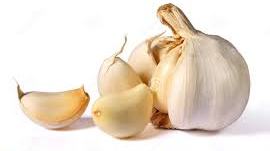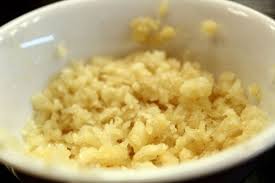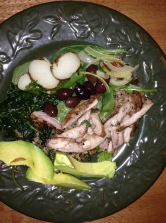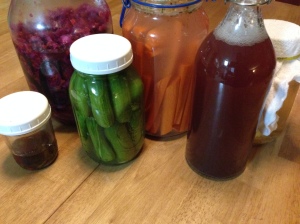To be sure, it’s never going to be just one thing that will make all the difference needed to make great changes in your vibrant health. However, one has to start somewhere, and assuming you have all kicked that smoking habit, then this one thing should be next. That one thing in my opinion is soda…..when I lived in Western New York State, it was known as Pop. Fizzy. Soft Drinks…whatever you call it, it’s simply got to go. I’d say the sugar content is just about the number one reason, and we’ll delve into sugar in much greater detail at another time, but it’s crazy what else is in there. It’s hard to imagine, but the endless marketing dollars at some of the worlds largest soda/beverage companies can sway the masses significantly to make it look like soda is actually almost good for you. I heard one time a good way to think of what a soda does to your body is to think about taking a shower in it…imagine how you feel toweling off after a fine soda shower.
I grew up rarely having soda in our house…..my Mom always had a few no-name brands of 2-liter bottles stored in the basement pantry for when we had company, so it was only consumed in our house as a treat, even though it was often flat when we finally opened it. Unfortunately, I had my share of it working in the restaurant business through my 20’s and into my early 30’s, and yet when I finally gave it up it was no big deal for me. Now I take a sip and it is pretty repulsive.
Since we’ll cover the artificial sweeteners at some point in the future, let’s just touch on it here (in the form of High Fructose Corn Syrup). This image alone is pretty telling (courtesy of www.sugarstacks.com):
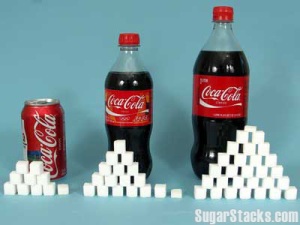
This image is used for a visual aid only (and it works for me!), and although the image doesn’t take into account the different kinds of sugar out there, there is obviously a difference in how each type is metabolized. A recent CDC report stated that one third of the American people are pre-diabetic and 90% of them do not know it. High blood sugar is a sure fire way to a train wreck, and soda in the Standard American Diet (SAD) is clearly one of the leading causes. The 28th annual Report on Eating Patterns in America compiled by NPD, a consumer marketing Research Group lists carbonated soft drinks” as #4 of the top ten foods we consume that account for 50% of our food intake. Considering about 1.6 Billion cans of Coca Cola are consumed each DAY worldwide, that’s a staggering amount of sugar by that one brand alone.
Here are the sugar facts in one 20oz bottle:
Sugars, total: 65g
Calories, total: 240
Calories from sugar: 240
YIKES!
High Fructose Corn Syrup (HFCS) – At it’s core, keep in mind that ANY food, or ‘food like product’ (as Michael Pollen likes to call it) that is processed in any way, is degraded nutritionally from the start. So, while some sugars are ‘better’ than others, HFCS is highly processed for sure, and Fructose itself is known to be 7 times more harmful than sugar alone. Fructose goes immediately to the liver to get processed, and when there is too much of it, like in the typical western diet, it gets metabolized into fat and NOT energy like its other sugar-cousin, glucose. Keep in mind though, sugar and HFCS contain relatively the same amount of fructose, so replacing straight sugar for HFCS is not an option, either. Also keep in mind that just about every processed food contains HFCS, so it’s not easy to stay away from in most grocery stores.
Carmel color: We’re attracted to things of all colors, right? Take one look at the guide put together by the Center for Science in the public interest and you may take a much closer look at some of the labels of the food you eat. Caramel Coloring is made from the heating of a sugar compound (usually high-dextrose corn syrup), often together with ammonium compounds, acids, or alkalis, used most often to give food and drink products their rich, generally dark brown coloring. When produced with Ammonia like it is, several studies show that they produce several substances that according to the State of California EPA are carcinogenic. In response to these findings, both Coke and Pepsi have said they would reduce the amounts in their products (NOT to remove it or find an alternative of course), but gave no time table to do so. Interestingly, the FDA has limits for these same chemicals that are 10 times higher than California, and yet even that low level from samples found in testing done in California may be enough to exceed the FDA’s threshold. Let’s put all these figures aside, and decide if it’s somehow OK if something you put into your body doesn’t kill you today, but over time instead? I think not!
Phosphoric Acid (PA). If you are taking calcium supplements while maintaining the SAD, you’re wasting your $ in my opinion. PA is linked to Osteoporosis, because higher levels of phosphates lead to lower levels of calcium. When this happens, your body instinctively pulls calcium out of the bones to compensate…..sounds like a vicious cycle, and today many docs have come full circle, saying calcium supplements are no longer recommended for prevention of osteoporosis. See details in this article by well known acupuncturist Chris Kresser. Also, check out the book “The Calcium Lie” by Robert Thompson, MD. He explains that the exclusive focus on calcium supplementation is likely to worsen bone density and actually increase your risk for osteoporosis. He believes over consumption of calcium creates other mineral deficiencies and imbalances that will increase your risk of heart disease, kidney stones, gallstones, osteoarthritis, hypothyroidism, obesity and type 2 diabetes. Finally, PA’s acidity is more than that of vinegar or lemon juice…something you cannot taste because of the vast quantities of sugar. Have you ever heard that the SAD is a highly acidic one? Soda clearly is helping fuel this statistic.
Natural Flavors…for most sodas, this is completely unknown what this really is, as it is formulated in a lab somewhere. The FDA allows extremely broad oversight into what can be considered a natural flavor. However to give an example of a source for vanilla flavoring, commonly labeled as “castoreum” you may want to know that it is derived from the anal secretions of a beaver. Certainly fits the bill as a natural flavoring, but not one I am interested in ingesting.
And finally, caffeine…there are so many studies purporting the potential benefits of moderate amounts of caffeine, so its ok, right? Not in the Big Gulp, six-pack a day volume so many Americans consume it in today. Caffeine is a psychoactive, addictive stimulant touted as the world’s most widely used drug. While I don’t drink coffee (I Love the smell of the beans, just never liked the taste), I do like the occasional green tea, and know caffeine is naturally found in many other areas. The average American drinks about 7-10 pounds of coffee per year, most of it caffeinated. However, ask anyone who tried to stop drinking soda after a long standing love affair with it, and they will tell you withdrawal is not easy. Caffeine is a drug, plain and simple, and yet a cup or two of organic coffee, or green tea a day is nothing to worry about. When combined with the rest of the chemicals found in most soda products on the market, too much caffeine is where the problem lies.
Here is a 2 minute, stellar, yet sarcastic soda commercial you must see. Click here.
Quote of the day:
“No matter how hard the past, you can always begin again.” ~Buddha
[Author edit – 11-08-13] Click here for an interesting follow up article.



